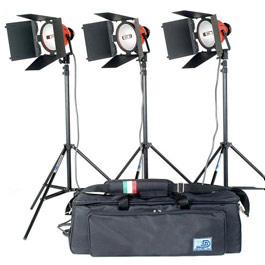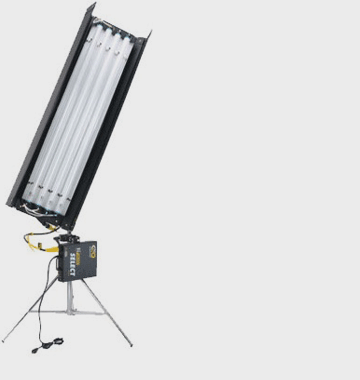All cameramen need some kind of basic lighting set up, all offer different pros and cons at different price points. Here is a quick round up of the differrent set ups available.
1) Tungsten:

Pros: Cheap, powerful, high quality light source
Cons: Heavy, hot, not always dimable
These lights have been around for a long time, the advantage of this is that they are therefore often really cheap. You can buy a set of three lights incredibly cheaply as many cameramen are moving towards more modern lights such as LED. Another advantage of these lights is the power: an 850 watt red head has a hell of a lot more power than an LED light panel. This extra power can also work against you as theses lights are usually not dimable, so you have to get around this with huge amounts of diffusion paper, or by bouncing the light off something. There is also the option of buying lower wattage tungsten lights if you know you won't need the excess power. Another plus for tungsten is the quality of the light. A simple tungsten bulb is a much more reliable source of light than an LED light as it transmits the full spectrum of light. You can read more on this here. The light from these lamps is typically very hard, this however is often useful, and if you need a softer light source, a Chimera soft box or some diffusion and a bit of distance will soften it. And now for a few disadvantages. Tungsten lights are incredibly inefficient, meaning they get really hot. Several of these beasts burning away for hours and you'll have a hot room, you also have to let them cool before packing them as if you touch them, you'll realise they are hotter than the surface of the sun. The next disadvantage is the size and weight. For the most part this doesn't bother me, but if you are going to fly or travel a lot with you kit, it could become a pain.
LED

Pros: Lightweight, bi colour, battery powered, efficient, dimable
Cons: Poor quality light source, not powerful
LEDs have flooded the market in the past few years. The technology behind these is constantly and rapidly improving, so I am sure they will be the main light for everything before long, however, as it stands there are some limitations, but first a few of the good points. Having the option to battery power is a massive plus. Many important buildings will want to see PAT certificates before you are allowed to plug them into the wall, and some are so paranoid they won't allow anything to be plugged in (St Pauls Cathedral in London is one such place that springs to mind). Battery power allows you to get around this. Another plus to battery power is, it saves time finding power points and running cable, in a quick turn around job, this can be invaluable. Being able to switch between a tungsten and daylight colour temperature and everything in between is fantastic, and a great time saver, as no gels or blub switching is needed. Not all LED panels are bi colour, so you need to check you have this function before buying. There are certain situations where no other light will do, for example a shot where you need to light on the move is really easy with an LED panel, someone can just walk holding the panel where you need it. Try this with a red head and a load if cable and you are likely to get in a mess. So why not shoot everything with LED? LED have a few limitations, firstly the light source just isn't high quality as mentioned before. LED light panels never really look that great as a key light source for an interview as the light just doesn't wrap around the face as nicely as something like a kino flow, attaching a chimera soft box can help limit this issue, but it doesn't solve it. The next issue is power. If you are in a bright room and you need to battle against the daylight an LED panel just won't cut it.
Fluorescent

Pros: Quality light source, dimable, low heat
Cons: bulbs must be switched for colour change
The kino flo is my go to light for so many situations, especially interviews, and has been for years. The light is dimable and really wraps nices around the face so you don't get any harsh shaddows. The ability to switch from tungsten to daylight colour bulbs is great, although obviously not as convenient as LED bi-colour switching. The units are fairly light weight and transportable. I have been using a kino flo diva light for many years, flying it all over the world and it is still running well with almost no issues since I bought it. Bulbs last a long time, and the unit doesn't overheat. Price wise these do cost more that the other two options above, but you do get a good quality light.
